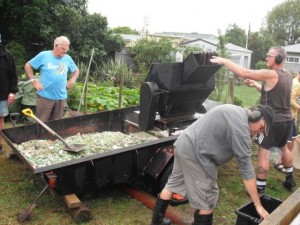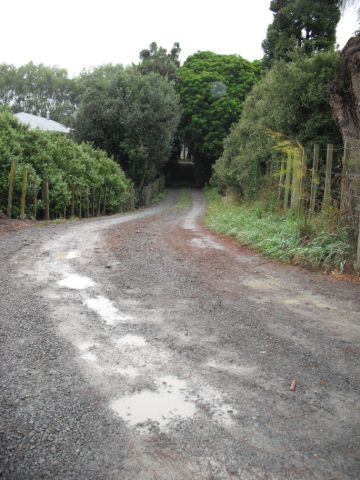Kāpiti Coast’s Greenest Street: A crushing morning
Blog 3: by Stacey Gasson
Going into their fourth month of Kāpiti Coast’s Greenest Street competition, participants are really hitting their stride. On Saturday I went to see one of Andy Fraser’s pet projects come to fruition. Andy and Monica Fraser and their teenaged daughters, Alana and Hinewai, are part of Te Roto Road, Ōtaki’s entry in the competition. With the know-how and ingenuity of Te Horo local, Barry Lucinsky, Andy and his neighbours spent a morning converting four months of empty wine and beer bottles into fill for the potholes in his metalled driveway.
Barry’s business, Silica Glass Crushers, crushes bottles for roading surfaces around the country using a portable 13-horse power machine he designed himself. Recently he extended this to crushing 5 tonnes of mussel shell to be used by a district council for filtering heavy metals from stormwater. Barry’s a bit of a local legend for his environmental creativity, which includes reviving Keep New Zealand Beautiful (from which he retired at 75) and inventing the KiwiLoo (a portable toilet often seen along New Zealand roadsides). Andy tells me Barry’s been taking an interest in Te Roto Road’s activities and has come out today in exchange for a few bags of chook pellets.
The key to today’s exercise has been Andy’s planning: he’s been keen on this since the start of the competition in October last year and quickly
instigated a glass collection point for his street. The racecourse across the road has kindly allowed them to park a trailer and woolsacks on their land, enabling everyone to drop off their bottles as they walk or drive past.
Having amassed two woolsacks of bottles from his street since the start of the competition (assuring me that none of it’s his), Andy’s keen to “give it a go and see how far it goes”. After just 45 minutes of mechanical roaring, both sacks have been reduced to 5mm chip. There are still some bigger bits in there, but Andy explains they’ll screen it and re-crush the larger pieces later at their leisure. Like his crusher, Barry’s screening process is refreshingly low-tech – the crushings are shovelled into a sieve over a 40-gallon drum then rocked until the fines have fallen through, leaving the larger pieces behind.
I’ve seen the finished product in use on a local café’s driveway and have to say it’s very pretty – light green/white and sparkly – but I’m curious to find out how much work is involved in making a usable product from ‘broken’ bottles. Very little as it turns out. While I thought it may have some sharpness to it, the grinding process has very effectively taken the edges off. This is demonstrated by the containers of 1mm crushings that are being passed around – I rub it between my fingers and just get a slightly prickly sensation. I’m told the degree of sharpness also depends on the quality of glass used, with wine bottles being the best. As an added benefit, it apparently sets like concrete once it’s spread.
All in all, the morning seems to be rated a success. Not only has their collective effort yielded a few barrows of fill, but they’ve “saved a bit of petrol and given a good excuse for a drink”. Cheers.
a WordPress rating system
a WordPress rating system
Tags: Community, green, Sustainability






Voices of our community